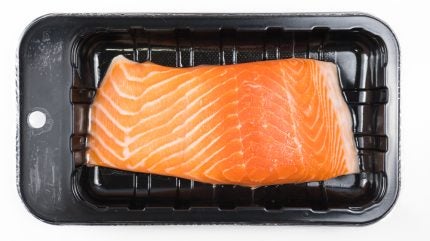
Salmon packaging combines advanced preservation, clever material design, and sustainability innovations to protect one of the world’s most valued seafoods.
Given salmon’s delicate and perishable nature, packaging solutions have evolved far beyond simple wrapping.

Discover B2B Marketing That Performs
Combine business intelligence and editorial excellence to reach engaged professionals across 36 leading media platforms.
Today, they form a sophisticated system designed to extend shelf life, maintain quality, and present the product attractively in a competitive marketplace.
Preserving freshness with advanced technology
The primary challenge in salmon packaging is keeping the fish safe and appetising during storage and transport. A number of technologies are now common in the seafood industry.
Modified atmosphere packaging (MAP) involves replacing the air inside the pack with a mix of gases such as carbon dioxide and nitrogen. This slows the growth of bacteria while keeping the fish’s natural taste and texture intact for longer.
Vacuum packaging achieves preservation by removing air before sealing, which reduces oxygen exposure. This is crucial for delaying spoilage and protecting the oils in salmon from becoming rancid.

US Tariffs are shifting - will you react or anticipate?
Don’t let policy changes catch you off guard. Stay proactive with real-time data and expert analysis.
By GlobalDataVacuum skin packaging (VSP) offers an even more advanced option. A clear film is sealed tightly around the salmon fillet, locking in moisture and preventing leaks. The transparent design also allows shoppers to view the fish from all angles, reinforcing confidence in its freshness and quality.
Materials that make the difference
Beyond preservation techniques, the choice of materials plays a major role in ensuring salmon stays appealing.
Multi-layer films are widely used as they create strong barriers against oxygen, moisture, and odours. These materials safeguard freshness during distribution and storage.
For premium smoked salmon, foil-laminated boards provide both durability and a sense of luxury, making the product stand out on the shelf.
In packs of fresh salmon fillets, absorbent pads are often included to soak up excess liquid. This keeps the packaging clean and reduces bacterial risks, while also improving presentation for consumers.
By combining high-performance materials with advanced sealing methods, salmon packaging protects both the product’s integrity and its visual appeal.
Sustainability driving innovation
With sustainability now central to food packaging, salmon producers are investing in new approaches that reduce environmental impact without compromising safety.
Recyclable trays made from high-density polyethylene (HDPE) and compostable films sourced from renewable plant fibres are gaining traction as eco-friendly alternatives to conventional plastics.
At the same time, research is advancing into antimicrobial coatings, such as films containing chitosan, a natural compound derived from shellfish. These coatings have the potential to extend shelf life and minimise waste.
Transport packaging is also evolving, with sealed bulk boxes that prevent meltwater leakage and reduce environmental runoff.
On the consumer side, transparent packs with elegant yet minimal designs are becoming a hallmark of premium smoked salmon, signalling authenticity and quality.
The takeaway
The world of salmon packaging is far more complex than it appears at first glance.
From modified atmosphere systems and vacuum skin technology to recyclable trays and antimicrobial films, every aspect is carefully developed to balance freshness, safety, and sustainability.
For producers and consumers alike, effective packaging is vital—ensuring salmon reaches the table in peak condition while addressing the growing call for responsible, eco-conscious solutions.





